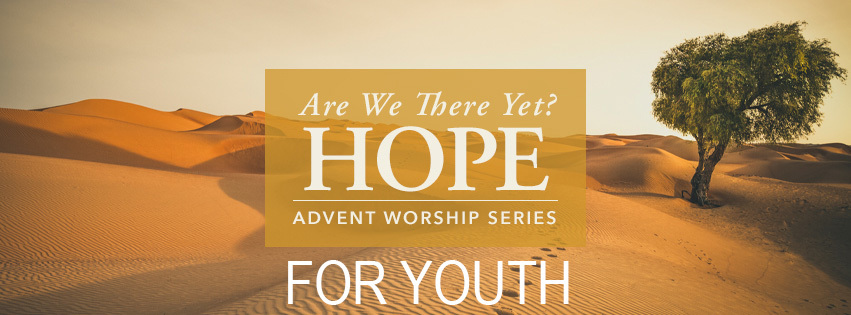Are We There Yet? - Hope

Week 2: December 8 – Hope
Matthew 3:1-2, John the Baptist prepares the way
Note the to Teacher
This lesson will help youth reflect on hope in a variety of ways. There are stories each of us loves that give us hope. Isaiah gives us a picture of God’s hope for the world, and youth will get a chance to use their creative imaginations to create their own fictional world that offers hope to all. Through dreaming of God’s hopeful vision for us all, we can begin to take small steps to make those dreams a reality.
Time Description of Activity
10 min. 1. Ice Breaker:
Stories of Hope - Stories are powerful; they can inspire us, move us, and fill us with hope. Depending on how small or big your group is, begin the lesson by inviting each person to share one of their favorite stories that give them hope from a book, movie, short story, etc. Ask youth to share why their favorite stories give them hope. As the leader you may need to start off and share your example.
5 min. 2. Read Scripture
Our scripture introduces us to John the Baptist and his teaching of repentance as he prepares for the arrival of Jesus.
Read Matthew 3:1-12
15 min. 3. Discussion:
- John the Baptist was pretty intense. He is confrontational and not afraid to get in your face. He talks about judgment and wrath to come. How do you think his message was received by those who heard it? How would his message be received today if he were to come in your church?
- John thought perhaps some were there to be baptized in order to escape judgment, and so he is asking them to check their heart and their motives. Are there right and wrong reasons to be baptized and to become a Christian? What are they?
- John tells the people to “produce fruit that shows you have changed your hearts and lives.” What do you think this was so important to John?
- What does it look like to produce fruits that show you have changed your hearts and lives?
- John says he will baptize with water, but Jesus, who is coming, will baptize with the Holy Spirit and fire. What do you believe the differences are between these two types of baptism?
Read Isaiah 11:1-10
- How does Isaiah paint a picture of hope?
- What do you think Isaiah means when he says “the wolf will live with the lamb, the leopard will down with the young goat, the young lion and calf will feed together?”
20 min. 4. Activity and Discussion
Create a world of hope:
Depending on the size of your group you can do this activity as a whole group or in small groups. Isaiah paints a picture of a world filled with hope – one of love and coming together, one where we do not hurt each other but live in harmony and peace as God’s creation.
Invite the students to imagine they get to create their own country. For the sake of the exercise they can pretend there is an unlimited amount of resources available. Their task is to create a world reflective of the hope Isaiah shares. If your youth were the ones in charge, what kind of country would they create to give those in their country a life of hope, peace, and love.
Invite them to think about the following questions:
- Who will rule your country? And how will they be chosen?
- How much of a budget will those in charge be responsible for? What will they use their budget for?
- What will the country be known for around the world?
- What will life look like for those who live there?
- What values will guide the decision making of those in charge?
After 10 minutes, invite the group to share their country with everyone else and why they made the decisions they did. Then you can ask the other groups, if the country presented is one that offers hope to the world.
50 min.
Needed Resources:
- Paper and pens/pencils for the activity

